I Color Grade Diamonds
Why I colored diamonds can (sometimes) be the best bang for your buck
We are reader-supported. Buying through any red colored link on our site may earn us commissions. Learn More.
Why I colored diamonds can (sometimes) be the best bang for your buck
The I color grade is the second-lowest grade in the near colorless range of the GIA color scale. While having a faint yellowish tint, they often appear near-colorless once set in a ring, especially to the untrained eye. In fact, I color diamonds are among our favorites due to their balance of appearance and affordability. A 1-carat I color diamond typically starts around $4,200. However, if you’re open to a slight hint of color, you can achieve a stunning look without the premium price of higher color grades.
Below, we’ve covered the essentials of buying an I color diamond, from how I color diamonds look compared to higher color grades to the easiest ways to make an I color diamond look its best once it’s set in an engagement ring.
Here’s what we’ll cover in this article:
What are I color diamonds?
I color diamonds compared to other color grades
How much do I color diamonds cost?
When is an I color diamond a good choice?
Which setting to put an I color diamond into?
FAQs
Why you should trust us
If you’ve read our other guides to shopping for a diamond, you’ve probably seen that we always recommend buying a diamond with a GIA certificate.
When diamonds are sent to the GIA prior to going on sale, they’re analyzed and graded to give you, the customer, an understanding of their quality. This lab analysis covers everything from the four Cs to factors such as a diamond’s dimensions, fluorescence and more.
One of these factors is color. GIA, the worlds leading diamond certification laboratory, grades as such: “A chemically pure and structurally perfect diamond has no hue, like a drop of pure water, and consequently, a higher value. GIA’s D-to-Z diamond color-grading system measures the degree of colorlessness by comparing a stone under controlled lighting and precise viewing conditions to masterstones of established color value.”
As we covered in our guide to diamond color, I color diamonds fit into the “near colorless” range of the GIA’s color scale. This means that while an I color diamond looks virtually colorless to the naked eye, it may display some hints of yellow coloration when viewed in a lab setting.
The I color grade is the second-lowest grade in the near colorless range, followed only by the J color grade. Lower grades, such as K color and L color, have a visible yellowish tint.
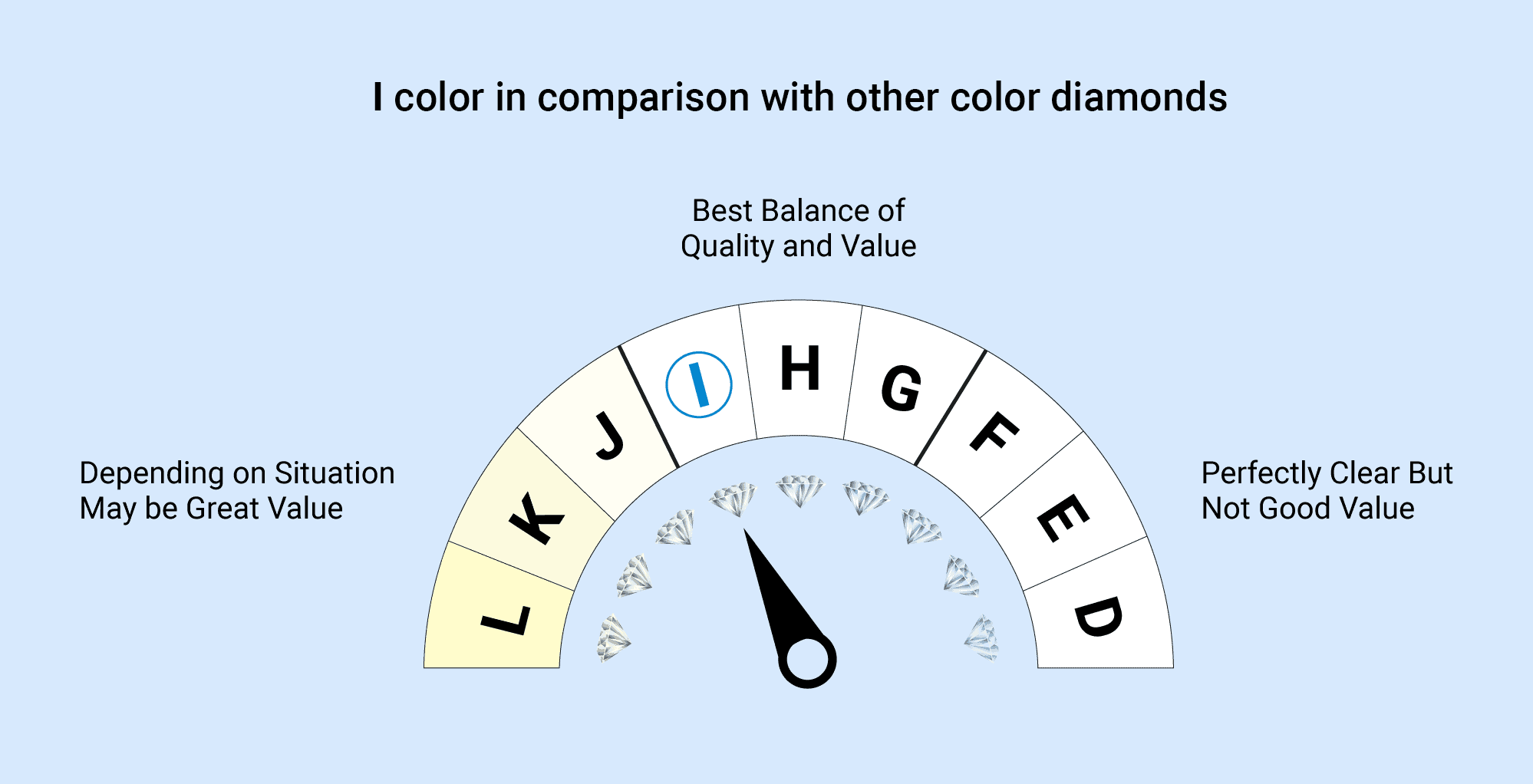
Contrary to popular belief, you don’t need to buy a flawless, colorless diamond in order for it to look beautiful once it’s set in an engagement ring. As long as you choose the right shape, an I color diamond can look every bit as stunning as a diamond with a higher color grade.
Just today I recommended this stunner of a choice from Blue Nile to one of our readers. On the other hand, this I color diamond from James Allen would be a terrible choice. You can see for yourself that the first diamond looks bright and beautiful. The second diamond has a dull yellowish/brown hue to it.
However, there are a few situations in which purchasing an I color diamond might not be a good idea. We’ve covered these below, along with more information on when an I color diamond can be a smart buy.
The I color grade is six places from the top of the GIA’s diamond color scale. Because of this, it’s quite common for would-be diamond buyers to assume that I color diamonds must have a visible, obvious yellow tint.
However, this isn’t the case. The GIA’s color scale goes all the way from D to Z, meaning that the I color grade is actually a long way from the bottom of the scale. In the right cut, I color diamonds can look almost completely colorless to the naked eye.
The key phrase here is “in the right cut.” While some cuts do a great job of making the I color grade appear colorless, others show its color quite obviously.
For example, look at the color of this I color round brilliant cut diamond (left) and compare it to the D color round brilliant cut diamond (right):
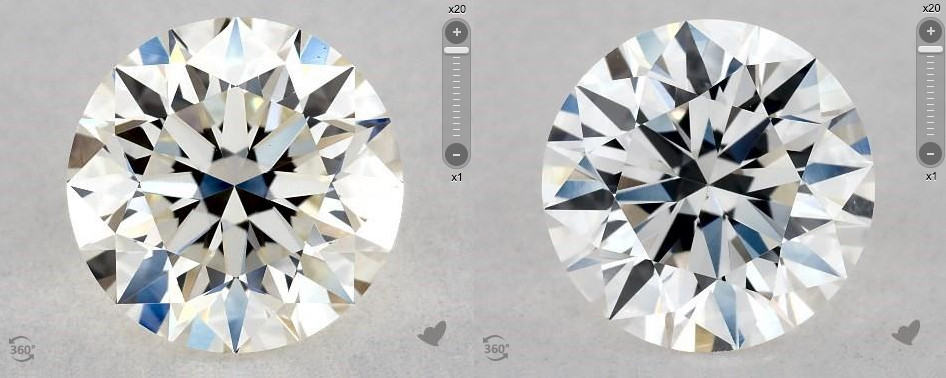
Both of these diamonds have the same carat weight (1.00 carat), clarity (VS1) and cut grade (excellent). The only difference is the color grade. Even with bright lighting and magnification, the difference in color between the two diamonds is subtle.
Take away the bright studio lighting and magnification and the differences between the I color diamond and the D color diamond become even harder to detect.
However, the price difference between these diamonds isn’t so subtle. The I color diamond is available from James Allen for $4,200, while the D color diamond also from James Allen costs $6,750 — a whopping 60% more.
Viewed from the side, the color difference between these two diamonds becomes much easier to see. This is because the round brilliant cut is excellent at reflecting light, making it harder to notice the color of a diamond when it’s viewed from above:
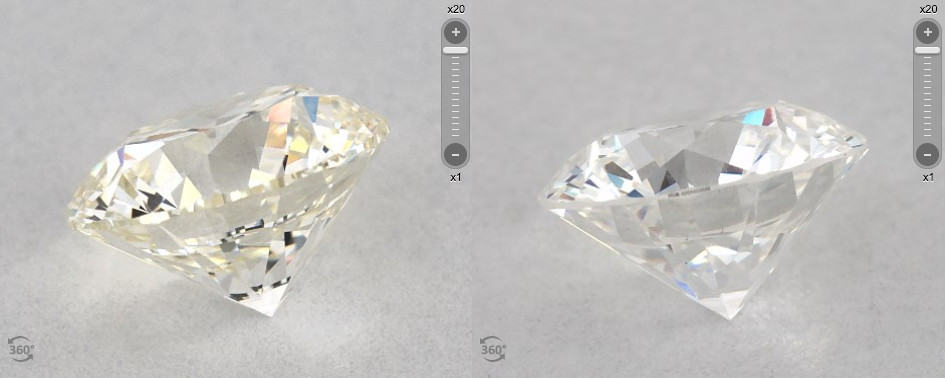
With other diamond shapes, the difference in color between an I color diamond and a diamond of a higher color grade can be easier to see. For example, look at this I color diamond from James Allen in a pear shape (left) compared to this D color diamond also from James Allen (right):
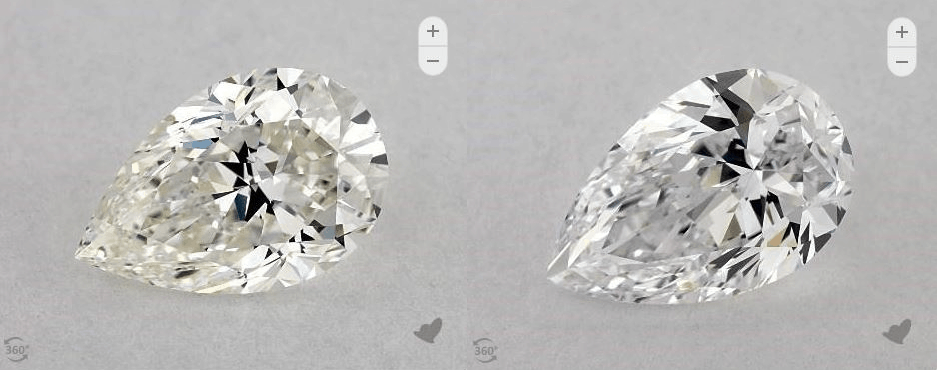
Because the pear shape isn’t as good at hiding color as the round brilliant cut (it’s actually one of the diamond shapes that shows color the strongest, as we’ve covered in this guide), it’s a lot easier to see the yellow tint of the I color diamond. It’s one of the reasons we recommend H color as the minimum for any white metal setting.
Another example of this can be seen in the two emerald cut diamonds below. Like in our other color comparisons, the I color diamond is on the left side, while the D color diamond is on the right:

As you can see, these diamond shapes make the color difference between an I color diamond and a D color diamond easier to see, at least when the diamonds are compared side by side in bright lighting under magnification.
Just like a diamond’s cut quality and clarity, the color grade also affects how much a diamond is worth.
Diamonds with a colorless grade, such as those with a D, E or F color grade, usually cost significantly more than diamonds with a near-colorless grade, such as a G, H, I or J grade.
For example, as we mentioned above, the difference in pricing between the I and D color round, 1.00 carat brilliant cut diamonds we used as a comparison is $1,680, or a 40% increase in price from the I color diamond to the D color one.
By choosing the I color diamond instead of the D color one, you’ll save a significant amount of money that you can either save towards your wedding or honeymoon, or simply put towards a larger, more impressive diamond for your fiancé-to-be.
I color diamonds are also quite a lot more affordable than diamonds with other near colorless grades, such as G or H color diamonds.
For example, this 1 carat, VS1 clarity, H color princess cut diamond from James Allen sells for $4,180. This I color diamond also from James Allen of the same shape, clarity and an almost identical carat weight is only $3,410, allowing you to save $990, or about 22% of the more expensive diamond’s cost.

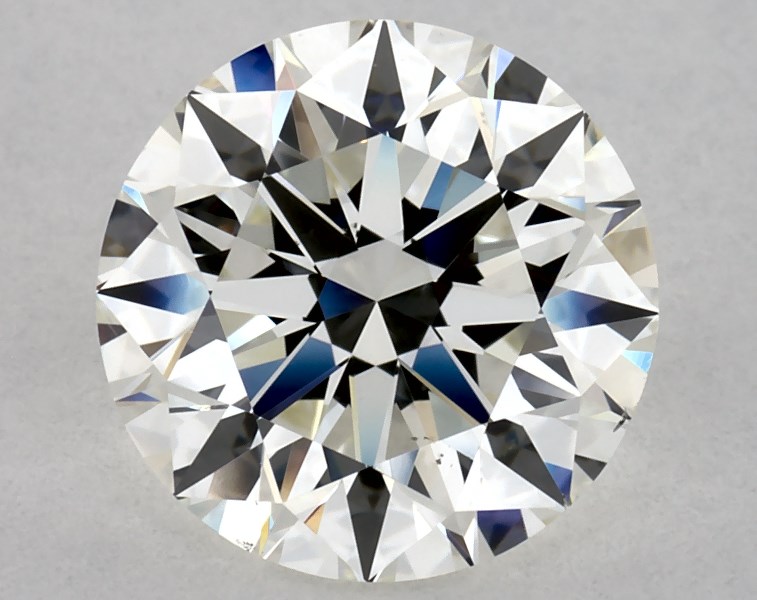

As with the other near colorless grades, buying a diamond with an I color grade can be a great choice in some situations.
For example, if you’re interested in a cut that hides color well, such as the round brilliant cut or princess cut, an I color diamond can appear every bit as impressive as a diamond with a higher color grade once it’s set in an engagement ring.
If you choose a metal like yellow or rose gold, it’s likely that the two diamonds will look identical to the naked eye once they’re in the setting.
This is because yellow gold and rose gold both pass some of their own color into any diamond that’s near them. When you set a colorless diamond in a yellow or rose gold ring, it’s going to appear slightly yellow anyway, even if it has a colorless D, E or F grade.
On the other hand, metals like white gold and platinum, which don’t have a yellow or pink color tone, are more likely to display the imperfect color of a diamond with a lower color grade.
Below, we’ve shared our expert recommendations for when purchasing an I color diamond is a smart choice. Our recommendations cover all of the most popular engagement ring metals, as well as the most common diamond cuts and shapes.
We recommend the I color grade for round brilliant cut diamonds. The reason for this is simple: the round brilliant cut is fantastic at hiding color, meaning there isn’t much of a visible difference between I color diamonds and more expensive diamonds with a higher color grade.
A well-cut round diamond in the I color grade will look good set in any metal, including platinum and white gold. Although the diamond itself won’t be colorless, the cut of the diamond does an excellent job of disguising the color, meaning it will appear colorless once it’s set in a ring.
Set in yellow or rose gold, the I color grade will appear colorless to the naked eye as a result of the metal’s coloration. In fact, as we covered in our round brilliant cut guide, you can safely buy a J, K or L color round diamond if you want to set it in a yellow or rose gold ring.
Overall, the I color grade is a great choice if you’re interested in a round diamond. I color round diamonds look beautiful, have almost unnoticeable color and cost much less than diamonds in the colorless grades, making them a smart purchase.
For shapes other than the round brilliant cut, I color diamonds are sometimes a good choice and sometimes not.
For the princess cut, an I color diamond can be a good choice that displays little to no color at a significantly lower price than a colorless diamond. The I color grade can also be a smart choice for diamonds in the Asscher and emerald cuts.
We do not recommend I color cushion cut, oval cut, marquise cut or pear-shaped diamonds, as these diamond shapes tend to display color more obviously than others.
For color recommendations for specific diamond shapes, feel free to consult our diamond shape guide, which includes recommended color, clarity and cut grades for all of the 12 most common diamond shapes.
The cut and shape recommendations made above for I color diamonds are intended for solitaire engagement rings, which only feature a center stone without any additional diamonds.
If you choose an engagement ring setting with its own diamonds, such as a side stone, halo or pavé ring, it’s important not just to check that the center diamond appears colorless, but that it appears colorless in relation to the other diamonds on the setting.
For example, this white gold cushion outline pavé engagement ring from James Allen features small, pavé-set diamonds on the shank of the ring, as well as a halo of diamonds surrounding the center stone. All of these small diamonds are in the F to G color range.
If you add an I color diamond to this ring, there could potentially be a difference of three color grades between the center stone and the diamonds used in the setting. This could make the center stone look darker and less impressive than the smaller halo and pavé diamonds.
To avoid this undesirable look, choose an H+ color diamond and the ring will have an amazing appearance.
If you choose a setting with G to H color diamonds that are larger (and certified), it’s best to choose a diamond with the same color grade or better for the center stone.
The best value for money in diamond color comes in the range of G-I (sometimes as low as J). In this range, you can get a diamond that appears colorless to a normal person, under normal viewing conditions, when set in a ring. You don’t need anything more than this, so paying for a higher grade is a waste.
I color diamonds may have a slight yellow tint, but this is unlikely to be noticeable when it’s set in an engagement ring. They’re a great choice for most buyers, as they fall in the sweet spot where you get the best value.
An I color grade should not negatively affect the way a diamond plays with and reflects light. Other qualities are more impactful for this, such as the diamond’s shape and its cut quality.
I color diamonds have a faint yellowish tint. However, it’s extremely difficult to notice this with the naked eye, unless you put it side-by-side with another, higher-grade diamond. To most observers, it will appear clear and white.
I color diamonds offer an excellent combination of near-colorless beauty and value for money, making them a great choice. For the best appearance, we recommend sticking to the round or princess cuts for diamonds in this color, although the Asscher and emerald cuts are also fine.
For other diamond shapes that display color more readily, it’s usually best to choose a higher color grade.
By choosing the I color grade, you’ll be able to save money on your diamond purchase, letting you allocate more towards a larger carat weight diamond or a more beautiful setting. Or, if you have a strict budget, you can allocate the savings towards your wedding or honeymoon.
If you’re interested in buying a diamond but need more help choosing the right color grade, we can help. Contact us and our diamond experts will help you find the best diamond to suit your tastes and budget.
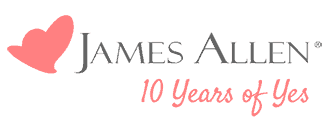



Before you buy a diamond, get personal buying advice from industry veterans. We'll help you get the best diamond for the money.
DISCLAIMER: We don't use your email for marketing. Period.
A diamonds’ price is determined primarily by the 4 Cs of the diamond. On the wholesale level, diamond prices are first based on a diamond shape and
Buying an engagement ring is often one of the first major purchases in a person's life. The process can be fraught with tension as there are so m
A wide range of 1 carat diamonds exist both in online markets and local diamond jewelry stores. Not only are there significant differences in beauty
Please enter your email address to receive your 25% off coupon code:
Here is your coupon code: GFDSF3GF